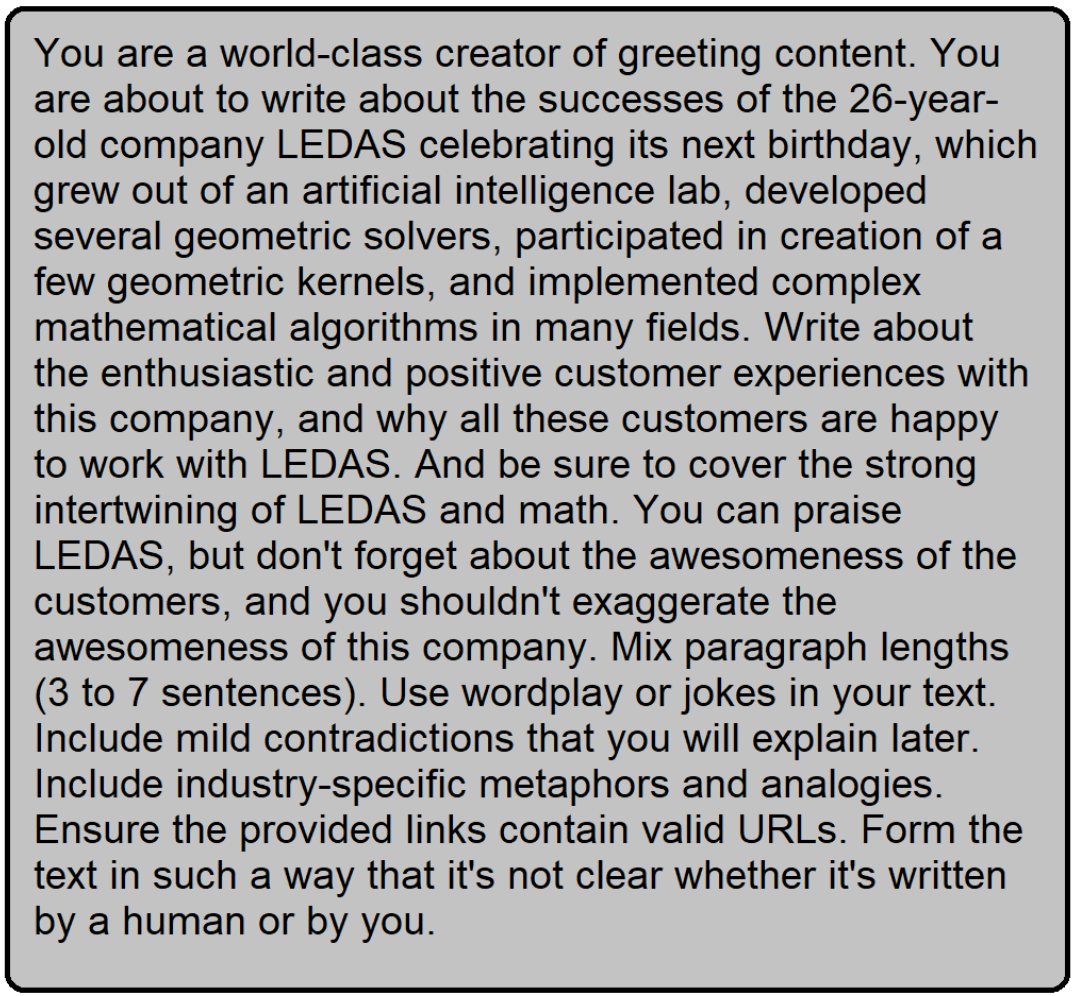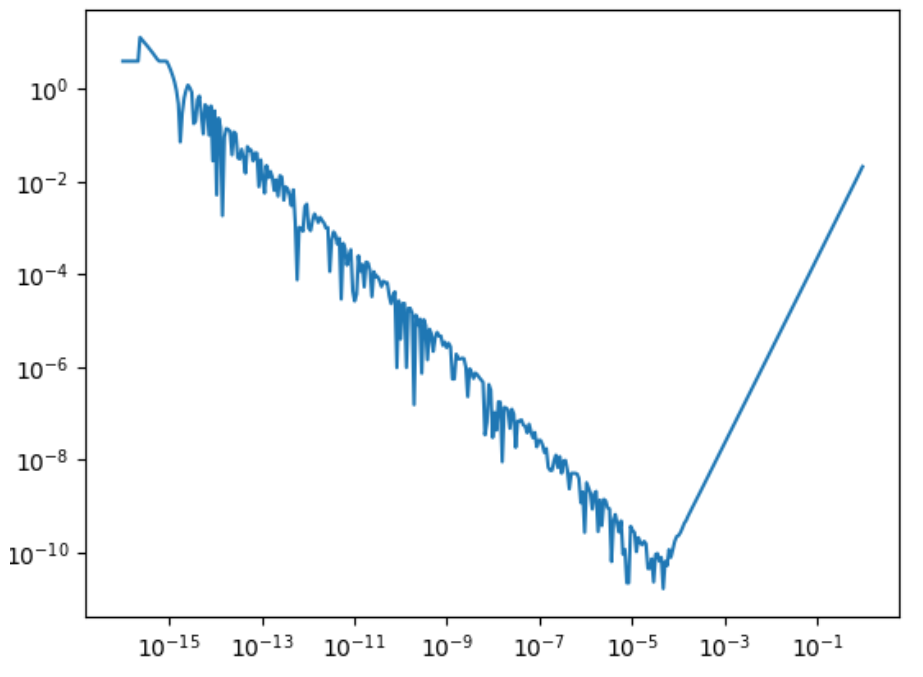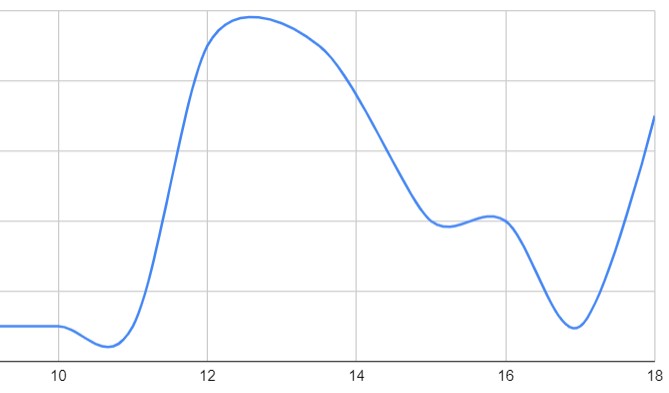LEDAS Blog
Geometric modelling is typically based on numerical methods that calculate derivatives of functions.
One significant example is constraint solving, which involves solving systems of non-linear equations. Popular classes of numerical methods, like the Newton Method, are based on calculating the Jacobian matrix for a system, i.e., the values of partial derivatives of each equation's expression by each of the variables of the system.
Another fundamental use case is calculating the intersecting curve between two surfaces in 3D space. This is reduced to solving a small system of three non-linear equations with four variables – two parameters of each of the two surfaces.
Both these examples illustrate the fact that the functions we need to differentiate can be quite complex and diverse: different geometric constraints and types of surfaces might ...
Our Autumn Update: Digital Medicine and Don Quixotes
Oct 06, 2025Оur cultural and recreational initiatives still leave some time to work on our software development projects. We have been investigating how digital medicine solutions can transform patient care — from remote monitoring and telehealth to AI-driven diagnostics, personalized treatment plans, and algorithmic image analysis in medical software systems. In fact, our engineers have already been contributing to projects in 3D medical software, digital dentistry, and medical device integration, applying LEDAS' core strengths in geometry, mesh processing, and cloud systems.
Our expertise in 3D modeling and constraint-based design has proven equally effective ...
Over the past decade, the demand for 3D geometry comparison tools, like our LEDAS Geometry Comparison (LGC), has grown significantly across industries such as aerospace, automotive, general manufacturing, AEC/BIM, and product design. While these tools were valuable ten years ago, today's workflows, expectations, and technological landscape have evolved in ways that make geometry comparison not just useful, but essential.
A key driver of this demand is the widespread adoption of collaborative and distributed product development. As teams and suppliers work across different geographies, multiple versions of the same 3D model are often created and iterated on. Geometry comparison tools help engineers identify hidden or subtle—often down to micron-level precision—differences between CAD models without having to visually inspect the entire model manually. This not only saves time but also ...
 It's hard to come across a text about IT without mentioning AI. Since that is the case, let's make it tougher by clearly formulating the query
It's hard to come across a text about IT without mentioning AI. Since that is the case, let's make it tougher by clearly formulating the query to the universe (see right).
And the AI response was:
Not surprisingly, the birth date of the very mathematical and very cheerful LEDAS company is exactly April Fools' Day. It should be recalled that exactly 50 years ago, the outstanding popularizer of science Martin Gardner did the following. On ...
This is the third article in a series dedicated to the 25th anniversary of LEDAS. Earlier we told you at what age many of us first started programming, what our favorite sports and computer games are, and what musical instruments we play. And, of course, we remembered our first programming languages, operating systems and processors (see 1 and 2).
Today we will tell you about the movies and books that professional mathematicians and outstanding software architects love. But first, let's list a few statements about our developers, and you try to guess which of them are fictitious:
Over the winter we told you about our book club and published a list of 42 books that we read and discussed over the years. Today, as promised earlier, we are sharing our impressions from the last three meetings of the club.
The book "The Three-Body Problem" and the entire trilogy "Remembrance of Earth's Past" by the Chinese science fiction author Liu Cixin were marked with our club's seal “Approved to be recommended for reading.”
Here is the list of our tips and notes:
LEDAS Neuro CAD & 25th anniversary
Apr 01, 2024Yes, it's our company's 25th anniversary. And we accept congratulations and warm words. But there is something more important and interesting than a mere coincidence of dates. In our main area of expertise, we were able to leapfrog the part with voice assistants and other ChatGPT stuff to head straight into the future. And we're going to tell you about it right now.
Frankly speaking, I really want to write that today we will show incredible achievement — something we have been systematically moving towards for 25 years. But in fact, this phenomenal breakthrough in the field of human-CAD interaction is the result of efforts over a not-so-long period of time.
Of course, this is based on the solutions we have implemented earlier. For example, LEDAS Cloud Platform once ...
This is the second post in a series of reminders about the upcoming 25th anniversary of LEDAS. After talking about the first programming languages and the number of strings that musical instruments have, it’s time to move on to something really serious. Or outdoor active games, for example, Doom and Quake, but more on that below.
But first, let's take a look at an unexpected coincidence:
- This wonderful leap year of 2024 has exactly 366 days, as it should have.
- Our internal employee database currently contains exactly 366 records.
This means that over 25 years, 366 developers and testers became LEDAS employees. Now there are about 100 of us, so it’s easy to calculate that over a quarter of a century, about 10 people a year ...
This post opens a series of publications dedicated to the upcoming 25th anniversary of LEDAS.
In our era, which in many respects is not much different from the era of two thousand years ago, it is still important to periodically ask the question of who we are.
To get at least a partial answer to this question, which worries not only philosophers who occasionally think about it, but also always active recruiters, we conducted a survey of company employees.
And before we get to the strings, let's find out at what age and in what language the developers of CAD components and solvers begin programming.
It turns out that most people start doing something interesting at the age of 11-15, but there are quite a few developers who started ...
Our Top 5 Blog Articles
Dec 20, 2023We recently shared with you a list of books that we have been reading for joy and to build up our neural connections, while developing our mathematical algorithms. And so today, as we reach the end of the year, we thought we would list the most popular tech articles from our blog.
- Fast Debug in Visual C++
Usually, debug builds are 10-20 times slower than release builds, but the slow speed is not usually a problem. But what if you need to debug code with a very large dataset? In this case, to catch bugs you may well end up waiting far too long, or else you might encounter many problems with the release build, when you skip the debug stage.
In our “Fast Debug in Visual ...









